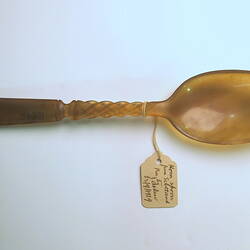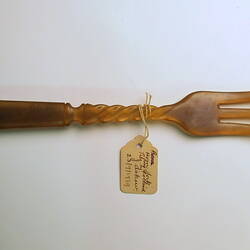Summary
Domestic fork made from horn. Said by donor to come from Scotland. The fork, together with other horn cutlery and a horn serviette ring, was donated to Museum Victoria in 1929 by John Askew. It is likely to have already been old at that time, so possibly dates to the 19th century. The donor was a prolific collector, and provided no further provenance with this donation.
A horn spoon dating to 1877 held by the Highland Folk Museum, Scotland, may shed light on this Scottish horn fork and other Scottish horn cutlery held by Museum Victoria. It 'represents the importance of the contribution of the 'travelling people' to the everyday life of Highland rural communities. They used the resources of the environment around them to create all sorts of domestic and working goods such as horn spoons, heather mats, pot scrubbers, woven creels etc. As well as working on the land, the travellers also excelled in metalwork from tinsmithing to the re-working of silver and gold.'
Physical Description
Fork with three prongs made from horn, pale fawn in colour. Half of handle spirally cut.
More Information
-
Collecting Areas
Home & Community, Sustainable Futures, Migration & Cultural Diversity
-
Acquisition Information
Donation from Mr John Askew, 23 Sep 1929
-
Place & Date Made
Scotland, 1800-1900
Probable place made; also likely date - it was already considered significant enough in 1940 for the NGV to acquire. -
Classification
-
Category
-
Discipline
-
Type of item
-
Keywords
Animal Products, Cutlery, Forks, Materials Science, Migration & Settlement, Scottish Communities, Domestic Equipment, Food & Drink Consumption


